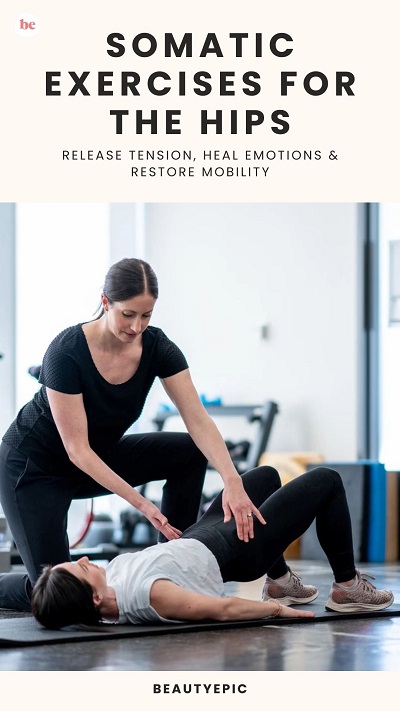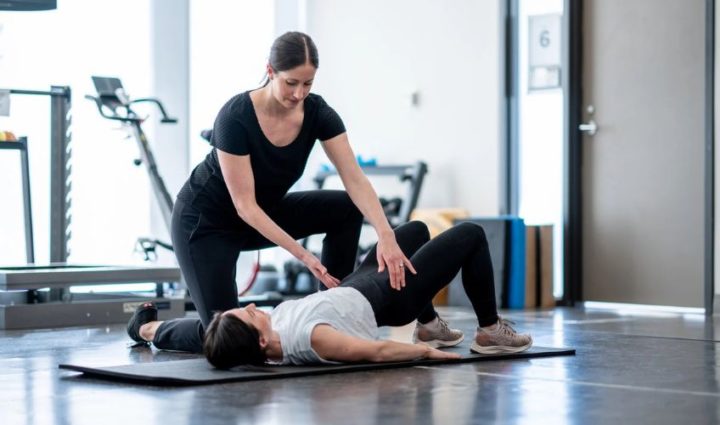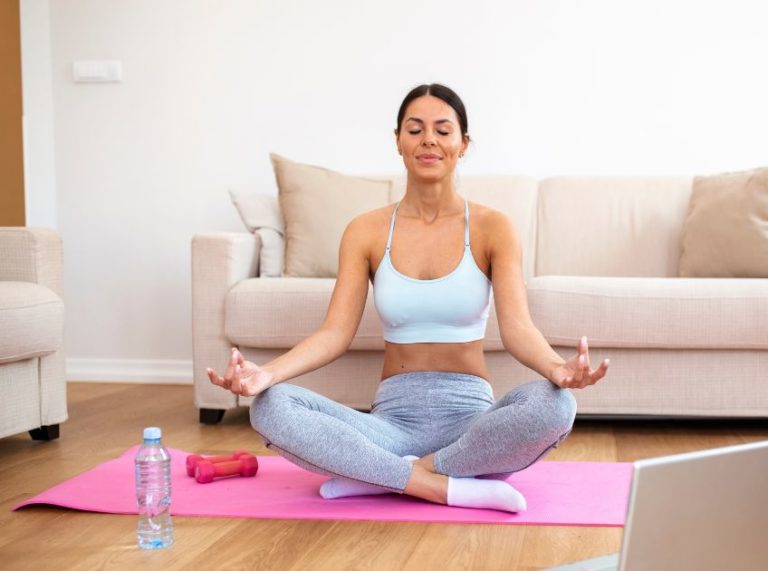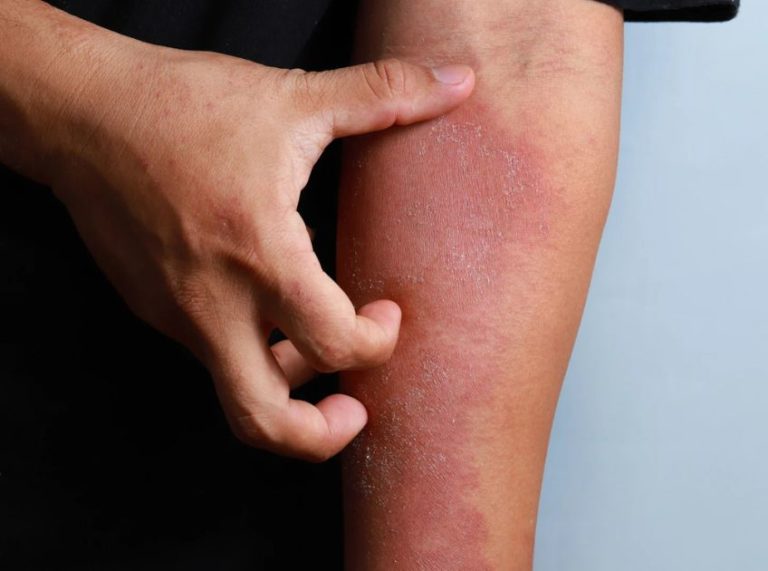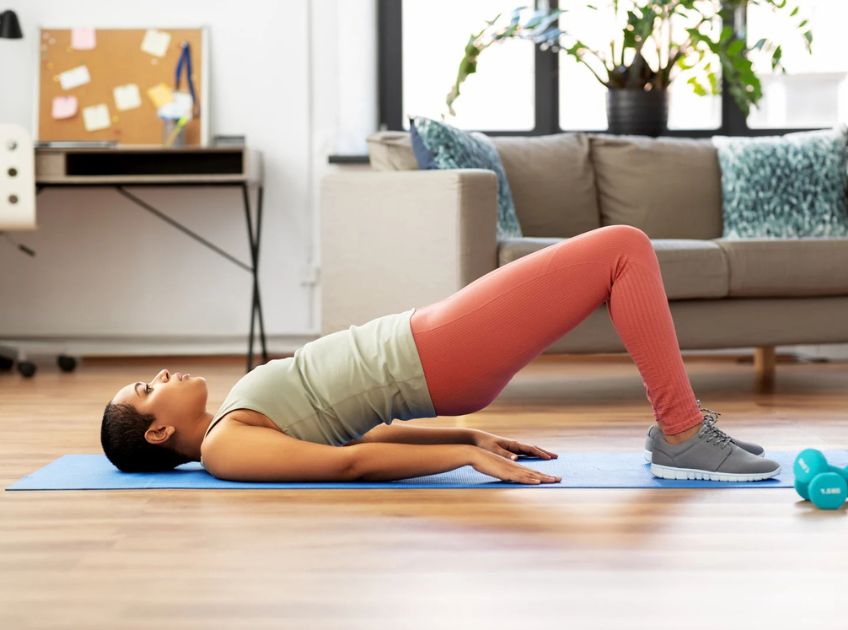
Important: This article is for informational purposes only. Please read our full disclaimer for more details.
Have you ever noticed how your hips feel tight and heavy after a stressful day? That’s because the hips aren’t just a physical joint; they’re also deeply connected to our emotions and nervous system. When we experience stress, anxiety, or unresolved trauma, these emotions can get “stored” in the hip region, leading to stiffness, discomfort, and restricted mobility.
Somatic exercises — a mind-body approach to movement — can help release this deeply held tension and restore both physical flexibility and emotional balance. In this blog, we’ll explore how somatic practices can improve hip mobility, emotional health, and overall well-being with practical exercises you can try today.
Hips and Emotions: What’s the Hidden Connection?
Your hips are more than just a structural powerhouse supporting walking, sitting, and balance. They are closely linked to the psoas muscle — often called the “muscle of the soul” — which plays a vital role in your fight-or-flight response.
When you experience stress, fear, or trauma, the nervous system sends signals to tighten the psoas as part of a natural protective mechanism. Over time, chronic stress can cause long-term tightness in the hip region, which may manifest as:
- Lower back pain
- Hip stiffness and reduced range of motion
- A sense of “heaviness” or discomfort in the pelvis
- Emotional overwhelm or unexplained anxiety
A 2017 study published in Frontiers in Psychology highlights that emotional experiences are deeply embodied, meaning that the body physically “remembers” emotional stress (1). The hips, due to their connection with the psoas and pelvic floor muscles, become a common storage site for unresolved feelings.
How Somatic Exercises Help Release Stored Emotions in the Hips
Somatic exercises focus on mindful, slow, and intentional movements designed to improve the connection between your body and brain. They retrain your nervous system, helping you release tension, trauma, and unconscious holding patterns stored in the hips.
Here’s how they work:
- Reprogram the nervous system: Slow, controlled movements send calming signals to the brain, reducing overactive stress responses.
- Enhance body awareness: You become more attuned to subtle sensations, making it easier to identify and release hidden tension.
- Support emotional healing: By relaxing tight muscles, somatic practices can unlock stored emotions, leading to a greater sense of relief and clarity.
- Improve flexibility and posture: Regular somatic work increases hip mobility and relieves discomfort caused by stiffness.
A 2020 clinical review in the Journal of Bodywork and Movement Therapies found that somatic movement therapies significantly improved chronic muscular tension and emotional regulation, making them highly effective for hip-related stress and trauma release (2).
5 Powerful Somatic Exercises to Release Hip Tension
Somatic exercises focus on slow, mindful movements designed to re-educate the nervous system, relieve stored tension, and improve hip flexibility. These movements don’t require force — instead, they encourage awareness and relaxation. Here’s a more comprehensive guide to five highly effective exercises:
1. Pelvic Tilts for Nervous System Reset
This gentle exercise teaches your body to release chronic holding patterns in the lower back and hips while improving your brain-body coordination.
How to Do It
- Lie flat on your back with knees bent and feet hip-width apart. Keep your arms relaxed by your sides.
- Inhale slowly, allowing your belly to rise slightly.
- As you exhale, gently tilt your pelvis backward, pressing your lower back into the floor.
- Inhale again, tilting the pelvis forward slightly to arch your lower back.
- Move slowly and mindfully, focusing on the sensation in your hips and lower spine.
- Repeat 10–12 cycles.
Breathing Tip
Breathe deeply into your lower belly, letting the breath guide the movement.
Benefits
- Relieves lower back tightness
- Restores natural pelvic alignment
- Calms the sympathetic nervous system, reducing stress
Variation
If you sit for long hours, place a small cushion beneath your lower back to enhance the release.
2. Hip Circles for Fluidity and Mobility
Hip circles encourage greater joint lubrication and help unlock stiffness in the hips and pelvis caused by stress or prolonged sitting.
How to Do It
- Sit cross-legged on the floor or on a yoga mat.
- Place your hands on your knees for support.
- Begin moving your upper body in small circular motions — leaning forward, to the side, back, and around.
- Start with gentle, slow circles for about 30 seconds, then gradually make the movements slightly larger.
- Switch directions and repeat.
Breathing Tip
- Inhale as you move forward, exhale as you circle back — syncing breath with motion deepens the relaxation effect.
Benefits
- Loosens tight hip joints
- Increases blood flow to the pelvic area
- Enhances mind-body awareness of stored tension
Variation
Try performing hip circles on all fours (“tabletop position”) to engage more muscle groups and deepen the release.
3. Somatic Bridge Pose for Emotional and Physical Release
Unlike traditional yoga bridges, this slow somatic version focuses on mindful control, helping release tight hip flexors while also soothing emotional blockages.
How to Do It
- Lie on your back with knees bent and feet flat, hip-width apart.
- Place your arms alongside your body, palms down.
- Inhale deeply, and as you exhale, slowly lift your hips toward the ceiling — vertebra by vertebra.
- Pause at the top for 2–3 breaths, feeling the stretch through the hips and thighs.
- Slowly lower your hips back to the ground, one vertebra at a time.
- Repeat 6–8 times.
Breathing Tip
- Focus on long, slow exhales to deepen relaxation and emotional release.
Benefits
- Opens hip flexors and strengthens glutes
- Improves spinal alignment
- Promotes a sense of lightness and emotional relief
Variation
Place a yoga block or pillow under your lower back and allow the hips to passively relax — a great option if you’re feeling fatigued.
4. Psoas Release with Constructive Rest Pose
The psoas muscle is often called the “muscle of the soul” because it directly links the nervous system, hips, and emotions. Chronic stress often causes the psoas to tighten, leading to hip and lower back discomfort. This pose allows the psoas to unwind naturally.
How to Do It
- Lie on your back with your knees bent and feet flat on the ground.
- Place a small pillow under your head for support if needed.
- Position your feet slightly wider than hip-width and let your knees gently fall toward each other.
- Close your eyes and focus on slow, deep breathing into your lower belly.
- Stay here for 5–10 minutes, letting the body soften and release tension naturally.
Breathing Tip
- Imagine sending your breath directly into the tight areas of your hips and lower belly.
Benefits
- Gently releases chronic psoas tension
- Calms the fight-or-flight response
- Promotes deep relaxation and nervous system balance
Variation
- Place a small cushion under your lower back for an added gentle stretch in the pelvic region.
5. Seated Somatic Breathing for Hip Relaxation
Sometimes, the best way to release tension in the hips is through intentional breathwork combined with mindful awareness. This exercise works particularly well if your tension feels emotionally rooted.
How to Do It
- Sit comfortably on a cushion or yoga block with your spine tall and relaxed.
- Place one hand on your lower belly and the other on your chest.
- Inhale deeply through the nose, allowing your belly to expand beneath your hand.
- Exhale slowly through the mouth, feeling the hips soften and relax.
- Continue for 3–5 minutes, visualizing stress melting away from the pelvic area.
Breathing Tip
- Try a 4-6 breathing pattern: inhale for 4 counts, exhale for 6 counts to activate the parasympathetic nervous system.
Benefits
- Improves mind-body connection
- Relaxes deep pelvic floor muscles
- Releases subtle emotional tension
Variation
While breathing, gently rock your hips side-to-side to enhance somatic awareness and promote deeper release.
Frequently Asked Questions (FAQ’S)
1. How often should I practice somatic exercises for my hips?
A. For best results, aim for 10–15 minutes daily. Consistency matters more than intensity.
2. Can somatic exercises help with lower back pain?
A. Yes. Since tight hips often contribute to lower back discomfort, somatic exercises improve flexibility and alignment, easing pressure on the spine.
3. Do I need prior experience to start somatic exercises?
A. Not at all. These exercises are gentle and beginner-friendly. Just focus on slow, mindful movements and deep breathing.
Your hips are more than just a physical joint — they’re a gateway to emotional release and nervous system balance. By practicing somatic exercises, you can:
- Unlock deep-seated tension
- Improve flexibility and posture
- Reduce stress and anxiety
- Restore emotional harmony
With consistent practice, you’ll notice lighter hips, calmer emotions, and better overall well-being. So take a few minutes each day to reconnect with your body — your mind, hips, and soul will thank you.
